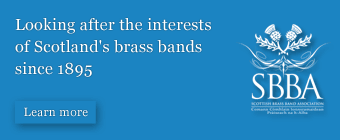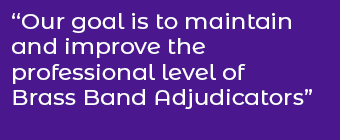
The changing face of British Bandsman magazine
Britain was left exhausted and almost bankrupt at the end of the Second World War, yet a sense of optimism soon emerged - from the creation of the NHS to the coronation of a new Queen.
The fabric of the brass band movement was also to undergo reform as it returned to competitive life from the ashes of conflict (although the Crystal Palace, home to the National Championships had been destroyed by a pre-war conflagration rather than the bombs of the Luftwaffe).
Links to the Victorian and Edwardian era also disappeared – Samuel Cope died in 1947, John Henry Iles in 1951. And whilst overall banding numbers were never to come close to those peak years there were still over 27,000 players filed in the National Brass Band Registry.
They wanted change too.
Morris and Ball
Vaughan Morris was the ostentatious dynamo that soon revelled in the organisational spotlight, yet it was the much more reserved figure of Eric Ball that took editorial responsibility of British Bandsman in 1951 to report on what promised to be an exciting decade ahead.
However, optimism soon became deference and worthy dullness.
In his history of the newspaper, Alf Hailstone reported that the pages made for ‘gloomy reading’. Ball urged patience and Christian forbearance, much like Sam Cope during the troubled 1930s, yet he himself could devote less time to it as the decade progressed.
Ball had no appetite for confrontation (a man of inherent kindness, his passions lay elsewhere). In his history of the newspaper, Alf Hailstone reported that the pages made for ‘gloomy reading’. Ball urged patience and Christian forbearance, much like Sam Cope during the troubled 1930s, yet he himself could devote less time to it as the decade progressed.
New approach
The dawn of the 1960s required a new approach. Newspaper readership was changing as the increasingly popular daily ‘red tops’ replaced deference with defiance.
The respected journalist Alfred Mackler took to editor’s seat in 1963, just at a time when brass banding was to undergo its own form of what Harold Wilson was to call the “white heat of technology” – from compositional revolution led by Gilbert Vinter to the change to low pitch instruments.
Mackler quickly modernised the approach and outlook; print styles, contest reports and articles changed, images were used, orthodoxies challenged. He soon moved on to bigger things and Eric Ball returned, a steady, but revitalised hand.
Mackler quickly modernised the approach and outlook; print styles, contest reports and articles changed, images were used, orthodoxies challenged.
By the time he left in 1967 the paper seemed well placed to move into the 1970s despite the uncertainties elsewhere as industrial disputes (the magazine closed for fortnight) and the demise of The Daily Herald newspaper were the outliers signalling a troubled decade to come.
The Brands
His successor was a man of the new age.
Geoffrey Brand was a skilled and enlightened polymath; a player, conductor, publisher and producer of substantial intellect and purpose. He was also blessed that his wife Violet was more than his equal in her field of expertise too.
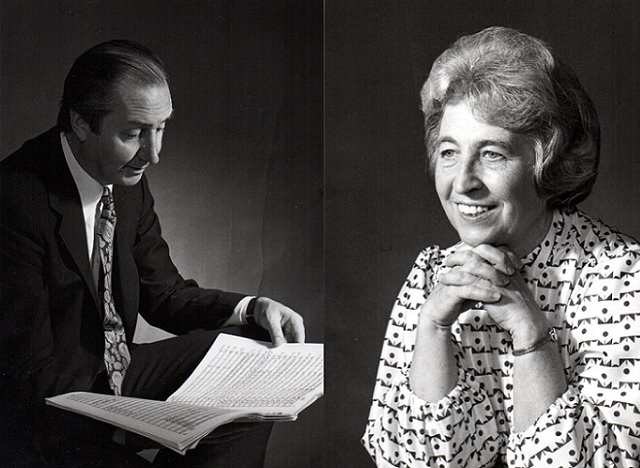
A remarkable partnership: Geoffrey and Violet Brand
Progressive response
A progressive response to the outside forces of industrial unrest and musical conservatism drove their agenda.
The editorial quality improved hugely, with Violet later stating that: “I became, during our eight years of involvement, increasingly aware of the historical importance of the British Bandsman, not only with regard to the development of the British brass band movement, but also its inter-relationship with the social history of the period from 1887.”
Their fearlessness often brought forthright correspondents to the fore – the letters page a must read. The libel laws were closely monitored.
Their fearlessness often brought forthright correspondents to the fore – the letters page a must read. The libel laws were closely monitored.
By now even the almost inexhaustible Vaughan Morris was wearied by his National Championship involvement. Brand, keen to expand his influence and with a sharp eye for good business, took it over and appointed Peter Wilson, an urbane 35-year-old Scotsman, to run it.
Troubled times
The mid 1970s though were troubled times – and for the Bandsman the sale to Robert Alexander in 1975 was that and more. Pessimism stalked its pages.
One correspondent wrote, “Unless we reshape our relationships, I see no prospect of our getting out of the muddy rut we secretly know we are in.”
One correspondent wrote, “Unless we reshape our relationships, I see no prospect of our getting out of the muddy rut we secretly know we are in.”
Perhaps that correspondent knew more than he let on – for it was Vaughan Morris, written under his non-de plume of David Nielsen. By 1976 the magazine was being published fortnightly.
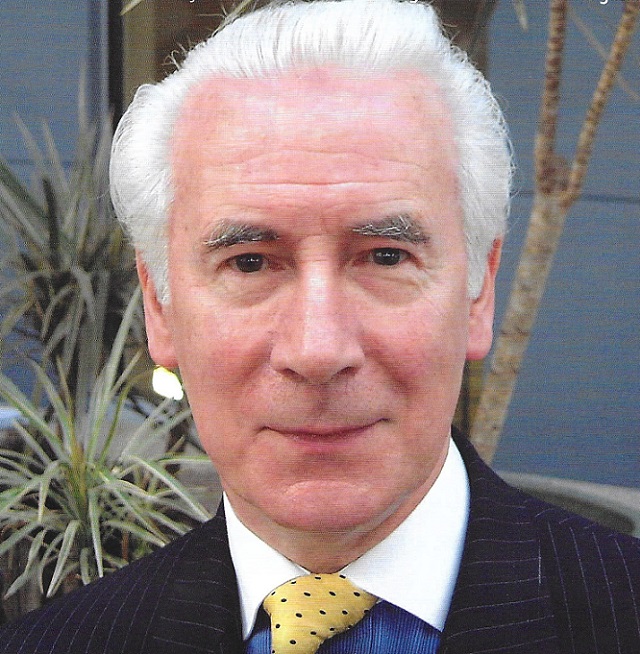
Peter Wilson: 23 years at the helm as Editor
A crook
Alexander, who had also bought the Nationals, was a crook. Well-meaning perhaps (as managing editor he brought in a specialist news editor, the correspondent Ron Massey and regular contributors such as Edward Gregson and George Thompson), but a crook, nonetheless.
Alexander, who had also bought the Nationals, was a crook.
It was only through the immense work of Peter Wilson, who became editor in 1977, and of Trevor Austin of Austin Catelinet Ltd, who rather benevolently purchased the magazine, that it survived. The Nationals dodged financial catastrophe by the skin of its financial teeth – bailed out by Boosey & Hawkes.
Stability
Over the next 23 years (Peter Wilson retired in 2000) it enjoyed stability at a time when social and industrial upheaval mirrored social and industrial change – especially in the printing world. The vastly experienced journalist, Nicola Bland played a central role in that, bringing a modern magazine outlook to its reporting that saw it revived.
In the concert programme he described the magazine as “the Bible of the brass band scene.”
In 1987 Peter proudly produced a fine 100th anniversary edition and a memorable ‘Concert of the Century’ in Manchester alongside a Centenary Luncheon and Service of Celebration.
In the concert programme he described the magazine as “the Bible of the brass band scene.”
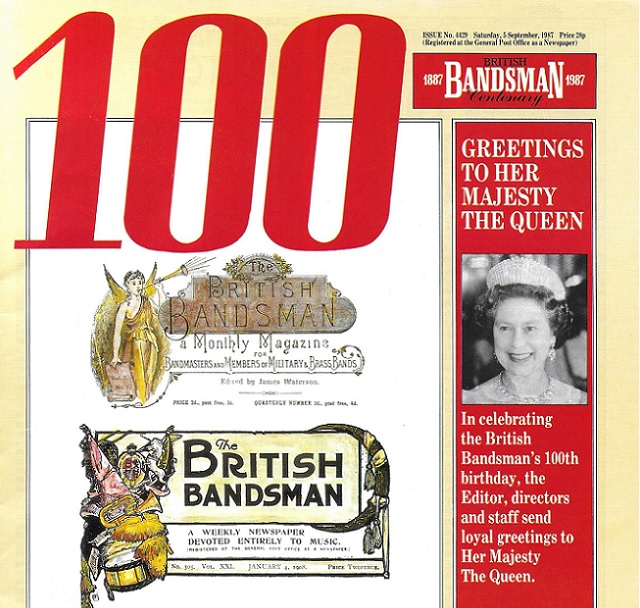
The centenary edition
21st century change
Although not totally omnipotent, it had until the turn of the 21st century, remained the dominant market force in brass band publishing. The arrival, first of the monthly Brass Band World magazine in 1991 and in 2001 of the on-line 4Barsrest changed that.
Acquired by Kapitol Media and Events in 2000, the magazine maintained its appeal through colour editions, musical analysis and feature articles.
Readership figures started to grow, but longer-term trends in advertising revenues and readership demographics had started to bite.
Although not totally omnipotent, it had until the turn of the 21st century, remained the dominant market force in brass band publishing. The arrival, first of the monthly Brass Band World magazine in 1991 and in 2001 of the on-line 4Barsrest changed that.
Important role
In 2004 it was sold to SATCoL (the commercial trading arm of the Salvation Army) under the editorship of another Scot, Kenneth Crookston, who had been a contributor since 1995.
Safeguarded much by its inhouse advertising revenue, it continued to hold an important role in questioning the direction the 21st century brass band movement was taking (Kenny Crookston went on to become CEO of Brass Bands England), whilst still maintaining its appeal as a weekly magazine.

The final chapter
Publishing costs though were now swallowing up a huge percentage of its income, and despite Kenny Crookston acquiring the magazine outright in 2015, the financial tide was ebbing away.
After 18 months it returned to being a monthly publication (as it was on its launch in 1887) and with its sale to IBB Media Ltd in 2018, the final print edition was launched at the September British Open that year, with new editor, Andrew Wainright, at the helm.
Final issue
However, the on-line subscription model never really caught the imagination of readers used to the free content provision of 4barsrest, and despite the efforts of its 14th and final editor, Mark Good, the final on-line issue was published on 9th June 2022.
However, the on-line subscription model never really caught the imagination of readers used to the free content provision of 4barsrest, and despite the efforts of its 14th and final editor, Mark Good, the final on-line issue was published on 9th June 2022.
Today it is an on-line web page presence run by Rob Tompkins – a brass band enthusiast who in many ways echoes the ethos of James Waterson and Sam Cope way back in 1887, in providing a means for bandsmen and women “to take sufficient interest in their art to maintain a magazine of their own upon its intrinsic merit.”
Over the past 135 years the British Bandsman magazine has faced challenges and changes with great fortitude and determination. Today those attributes are needed more than ever.
I for one wish it well and hope it succeeds.
Tim Mutum
Part 1: IN APPRECIATION
The British Bandsman magazine: Part 1: 1887 - 1952
https://www.4barsrest.com/articles/2021/1971.asp










